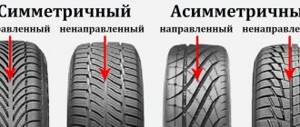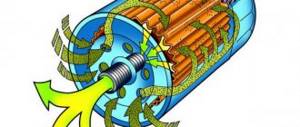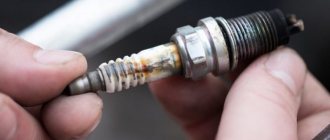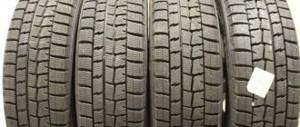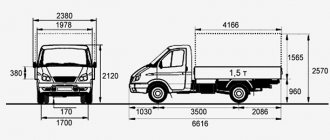Fuel filters are designed to clean fuel from foreign impurities. Any fuel contains some amount of dust, water and other impurities. Moreover, our fuel, especially in comparison with the same European analogues, is quite dirty. Therefore, having a good fuel filter is very important for long-term engine operation.
Below we will talk about the main types of fuel filters, their design, quality criteria, the features of fuel filters for diesel and gasoline engines, and also why it is important to change them on time. At the end of the article , watch a video on how to choose the right fuel filter for your car.
Fuel filter selection parameters
The question often arises, which fuel filter is better. Given the criticality of the filter element, careful attention must be paid to its selection. Compliance can be assessed using the following criteria:
- Developer. It is necessary to choose products directly from high-quality manufacturers. Budget segment products are purchased only in situations where an extreme need arises and there are no alternative solutions.
- Replacement frequency. Despite the instructions of the developers, the interval for replacing the filter element should be reduced to 2-3 engine oil changes.
- Filter density and quality. When choosing a filter insert, you can determine its quality yourself. The material used to make the filter is dense and hard, and at the same time allows gasoline or diesel fuel to pass through, preventing excessive loads on the pump.
- Filtration fineness. An indicator that determines the size of the fraction guaranteed to be retained by the filter element insert. For a car running on diesel fuel, this parameter will be 5 microns, for gasoline – approximately 10 microns.
- Guaranteed level of cleansing. The measurement is carried out as a percentage and reflects the number of elements holding the filter element. In the best models, this figure is 98-99%.
To know which fuel filter is best to install, you need to read the rating.
For injectors
The functional purpose of the component in question is identical, only the appearance and installation location differ. The soft filter is housed in a special metal housing with fuel pipes. The installation location will be the car's fuel line, mainly under the driver's seat.
SCT-Germany ST342
A similar device from a manufacturer from Germany offers products that are adequate in cost and quality. It is supplied in high-quality special packaging, on which you can find detailed information about use, compatibility of filter element models and contact details of the developer. The packaging style is branded and considered individual, with product details printed. There is no Russian language on the box, but the QR code links to a Russian-language page that is dedicated to the product in question. There is no information about the country of issue.
The filter element housing is made of metal, the “nut” type connection with a conical seal. The body material is made of steel; the package includes sealing rings made of copper. Entrances are closed using transport plugs. The filter is marked with information about the product, developer, compatibility, flow direction arrow and a warning about the need to relieve pressure. There is an anti-drainage valve at the inlet, but the filter element is blown in each direction.
Pros:
- removable connections, which is extremely convenient during self-replacement;
- The delivery comes with protective plugs on the pipe so that dust does not penetrate into the middle;
- reliable plastic clips included;
- adequate cost.
Minuses:
- quite large dimensions.
MANN-FILTER WK 612/5
The manufacturer in question is one of the largest in Europe. The filter element of this model is intended for injection cars. Delivery is carried out in high-quality packaging in a branded color and with plugs. The box contains information about the product, developer, compatibility and use. There is no Russian-language data, except for the inscription “Made in Israel”.
The filter has a “nut” type connection with a conical seal and small dimensions. On the filter element itself there is a reminder to follow safety during replacement, information about the product and developer, place of release, and a paint mark indicating the direction of flow. The filter element housing is made of aluminum and has an anti-drainage valve.
Pros:
- aluminum housing that does not corrode or clog the fuel system with oxidation;
- there is an anti-drainage valve;
- compactness.
Minuses:
- overpriced;
- Due to the small size of the filter, it requires frequent replacement.
Filter selection and how to change the fuel filter
As a rule, at the initial stage it is important to decide what type of fuel filter is being replaced, as well as where the fuel filter is located on a particular car. In other words, the complexity of the work will depend on where the fuel filter is located on the car, as well as which filter needs to be replaced. Let's take an example of how to change a fine gasoline filter, since this filter has to be changed quite often.
So, a fuel filter of this type needs to be purchased for replacement. When choosing, consider the following:
- Degree of filtration. It is advisable to purchase filters with the highest permissible degree of filtration, but not having a reduced throughput. On the one hand, the fuel supply will be complete in all modes, and on the other hand, even small particles along with the fuel will not get into the engine and power system.
- The total area of the filter element and the rubber seal that closes the entrance to the filter. For example, if there is no rubber seal, it is more difficult to replace such an element compared to analogues that have the specified seal.
Let us also add that regarding fine filters, the type of filter will depend on what kind of fuel system is installed. To summarize, all systems can be divided into the following categories:
- Carburetor dosing systems.
In this case, the required degree of purification for the filter will be 15-20 microns. Such a filter is not capable of catching the smallest particles, however, even after they enter the power system, this will not cause any particular harm to the carburetor and engine. In turn, the injection power system requires a higher degree of purification (5-10 microns). The reason is the presence of injection nozzles and increased requirements for maximum permissible pollution. Simply put, the ingress of small particles can damage the injectors, which will lead to clogging of the injector and failures in the fuel supply process. - Diesel filters (especially taking into account the high complexity and high cost of modern diesel power systems) must trap the smallest particles (from 5 microns or less). It is also important that the filter retains moisture, since water can damage the power system and the diesel engine itself.
It turns out that it is important to take into account not only the type of power system, but also the year of manufacture of the car, model, etc. As a rule, this information is enough to select the right fuel filter. It should also be taken into account that not in all cases analogues can be a complete replacement for original filters. For this reason, you need to make sure in advance whether one or another option is suitable for installation.
- Now let's move on to the replacement. Having selected the necessary gasoline or diesel filter, replacing fuel filters begins with preparing the car and the workplace. When working with the fuel system, it is important to pay maximum attention to safety precautions. The room must be ventilated, open fire, etc. is not allowed. It is highly recommended to have a fire extinguisher on hand.
If we talk about the replacement itself, first, it is important to know how to remove the fuel filter. As a rule, the fine fuel filter can be located in the engine compartment on diesel cars (above the engine), as well as next to the gas tank closer to the gas pump on gasoline cars (in the rear of the car).
Before you start replacing the filter (regardless of whether you are changing the fuel filter on a gasoline or diesel car), you should reduce the pressure in the fuel line. For example, to do this on a gasoline car, just pull out the fuel pump fuse, start the internal combustion engine and wait until the engine stalls. This will reduce the pressure and thereby avoid fuel leakage when removing the filter.
Further, replacing the fuel filter is also not carried out at this stage, since you still need to remove the negative terminal from the battery in order to avoid short circuits, sparking, etc. Please note that only after removing the terminal can you proceed to dismantling the old filter.
We also recommend reading the article on how to unscrew the oil filter without a key. From this article you will learn about the features of removing an engine oil filter, as well as how to remove such a filter without a special tool.
First, you should study the method of attaching the filter to the fuel line. The fact is that the fuel filter on different cars can be attached using bolts, latches, etc. Additionally, a screen for protection or a bracket can be screwed on for better fixation; also, when removing, you need to take into account the possible presence of sealing gaskets, washers and other elements.
After removing the fasteners, you can wrap the old filter in a rag and remove the element from the car. Then you need to install a new filter, paying attention to which side the element should be facing. On the body there may be symbols in the form of arrows or IN/OUT inscriptions, indicating which side the fuel supply from the tank should be connected to and where it should exit after the filter passes further into the line.
The final stage is reassembly, as well as a full check of the fuel line connection. If cracks or kinks are found, worn and damaged parts must be replaced.
Now all that remains is to install the fuel pump fuse, then connect the negative terminal to the battery and start the engine. If the engine does not start after replacing the fuel filter, this is normal, since the pressure in the system was released before replacement. To start the engine, turn the starter motor for 10 seconds. 2-3 times. Usually this is enough to start the internal combustion engine.
For carburetors
It is a special instrument that does not have an outer shell. It is integrated directly into the engine fuel line; the installation location will be a special section under the hood. Taking into account the design of the car, the filter has various parameters, in the shape of a cylinder or a cone.
“Nevsky filter” NF-2000
Filter elements from the manufacturer “Nevsky Filter” are produced in St. Petersburg or Saratov. The holding that owns the company is also the owner of Filter Materials CJSC, a domestic developer of filter paper. The manufacturing company primarily focuses on domestically assembled cars.
The filter element of the product in question is intended for old cars with a carburetor. A small transparent case with plastic pipes and a small filter. Such a device is supplied without packaging, in an ordinary polyethylene bag, but information about the manufacturer and model of the product is printed on the body.
Pros:
- compatibility with many Russian cars;
- replacement is not needed for a long period - some products will last up to 40 thousand kilometers;
- adequate cost;
Minuses:
- small filter area.
FILTRON PS 842
The filters in question from the manufacturer FILTRON occupy leading positions in the equipment of any car. The developer is considered a leader in the production of filtering devices.
An affordable, but at the same time quite effective gasoline filter for engines with a carburetor. The production is carried out by a manufacturer from Poland. It can be used to replace branded cleaners of various foreign cars - over 100 models from 12 companies from Europe allow the use of PS 842, the longest list is from Ford.
Pros:
- small dimensions;
- high-quality assembly;
- duration of operation of the synthetic filter material;
- adequate cost.
Minuses:
- a fairly large number of fakes, despite the low price of the consumable device itself and the security measures taken by the developer (QR code, laser inscriptions, etc.).
Fuel filters: features and service life
Let us immediately note that several types of fuel filters are used on the car. In this case, fuel filters are usually divided into fine filters and coarse filters. Simply put, coarse filters are a strainer (such as a fuel pump filter) as well as sediment filters.
The main task is to capture large particles. The system also contains a fine fuel filter, which traps small particles and deposits. Such a filter is a flask, inside of which multilayer cardboard is usually used to trap particles of rust, debris, dust, etc.
The main task is to avoid debris getting into the fuel system line, the components of which have a small cross-section and ingress of dirt can quickly lead to breakdown.
It is important to understand that the resource of the fuel filter is quite limited, both for fine filters and if the problem affects the coarse fuel filter. By the way, in practice the fine filter lasts much less. It turns out that in order to understand when to change the fuel filter, you need to take into account its type.
As a rule, it is recommended to change the fine fuel filter every 20 - 30 thousand kilometers. This interval is allowed if the car runs only on high-quality fuel, which is filled at proven gas stations. If there are doubts about the quality of the fuel, it is optimal to reduce the replacement interval to 15 - 20 thousand km.
As for coarse filters, for example, on gasoline cars with an injector that have a fuel pump filter mesh in the tank, replacing the specified fuel pump mesh may be required after 80-100 thousand km. mileage However, it may be necessary to change the filter earlier if the fuel tank is very dirty, it has not been washed for a long time, etc.
One way or another, experienced specialists recommend changing fine fuel filters at every service, and coarse filters every 50-60 thousand km. mileage This will avoid premature breakdowns of fuel system elements and increase the life of the internal combustion engine itself.
For diesels
The main purpose of such products is to prevent the entry of abrasive impurities and resins formed as a result of chemical reactions into the fuel line and combustion chambers. Due to the high concentration of moisture in diesel fuel, the corresponding filters condense water and remove it in significant quantities from the fuel supply equipment.
MAHLE KX 204 D
The filter cartridge from one of the most expensive developers on the automotive market actually justifies its cost. Here, high-quality paper is used, and the folding technology eliminates contact and crushing of the ribs during mechanical action. The dimensions of the cartridge are 7.1 by 12 cm, the diameter inside the cylinder is 19.7 mm. The device in question is intended for Opel, Renault and Nissan diesel cars produced in 2000-2011.
Pros:
- high-quality construction;
- easy running of even diesel fuel that has thickened in the cold without prolonged preheating;
- clearly adjusted distance between the filter paper petals.
Minuses:
- overpriced for each replacement cartridge.
SOGEFI Purflux CS862
The best fuel filters for diesel. The filter element, which was produced by a French manufacturer for the Ford Transit, became so successful that Ford decided to use it. Today it is installed on new cars that come off the assembly line. The reason will be the implemented technological solutions, which made it possible to create a virtually ideal device for diesel fuel.
Pros:
- comfortable modular assembly;
- chevron corrugation, which increases the filtration area by 1/5;
- good moisture removal in the amount of 4 to 10 microns – 99% effect;
- the water will be collected in a special tank, and a special indicator will indicate when it is full;
- There is a grounding pin that prevents the accumulation of static energy.
Minuses:
- difficult to find on sale, but can be purchased to order.
How to determine the quality of a fuel filter?
Even well-known developers are capable of producing defective products that were somehow not noticed in acceptance. Directly because of this, when choosing a filter, you need to focus on the following nuances:
- Paper quality and thickness. It will be reflected in the filter performance - the more uniform the thickness of the paper, the better the filtration and the less likely it is for dirt to pass past the filter element.
- Winding density. The higher the quality of the filter, the higher the winding density and the better the performance of the device.
- Uniform filling with dirt. When, during dismantling of a used filter element, heterogeneity and uneven filling are noticeable, the purchase of such a device should be abandoned in the future or the period of use should be reduced to 8-10,000 km.
Features of choosing a fuel filter for a diesel engine
Due to design nuances, diesel cars place increased demands on fuel quality. According to statistics, 80% of the total number of breakdowns of cars with diesel fuel are directly caused by faults in the fuel system. In this regard, such a filter must have the following characteristics:
- material – dense cellulose or synthesis of synthetics and cellulose;
- the form factor corresponds to the design of the car;
- purification level – 99%;
- dimensions of the filtered fraction – no more than 5 µm;
- the presence of a built-in moisture separator.
A useful option would be heating the fuel filter - a system that allows you to increase the temperature of the fuel in the filter to the required level. Thanks to it, it will be easier to start the engine at low temperatures.
The question often arises as to which fuel filter is best to purchase. To help buyers make their choice, this list has been compiled. The rating included the best fuel filter companies. The models are distinguished by their reliability and quality.
Signs of a clogged fuel filter
Unfortunately, not all owners follow the recommendations for replacing filters. Others consider reducing the interval unnecessary and drive for the stated 30 thousand km on one filter. and more. Also, no one is immune from the fact that you can accidentally pour low-quality fuel into the tank and damage the filter partially or completely.
In any case, if the fuel filter is clogged, certain signs and symptoms will indicate when to change this element. First of all, you need to replace the fuel filter if:
- traction and power disappeared;
- the engine does not start well;
- the engine started to misfire and is unstable;
- the fuel pump is humming;
- fuel leaks are visible in the area where the filter is installed;
As a rule, severely clogged fuel filters lead to the engine malfunctioning, as the fuel supply to the power unit is disrupted. In advanced cases, the car stalls or does not start.
If the filter is clogged, but not completely, then the car may accelerate jerkily, fuel consumption increases, and the power of the internal combustion engine is clearly reduced. To check this, you can first accelerate the car to 30-40 km/h, then sharply press the gas pedal and look at the acceleration efficiency.
If there are jerks, the speed does not pick up, acceleration occurs with dips, then this will often indicate that the fuel filter needs to be replaced. In this case, both the gas filter in the fuel tank and diesel fuel filters can become clogged, which depends on the type of car and its internal combustion engine.
